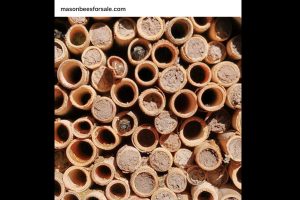Ideal Neighbor For The Home Gardener, The Mason Bee
Genus: Osmia, Family: Megachilidae, Species: mason bee. These are solitary, non-colonizing, nonaggressive bees that are excellent pollinators of orchards and gardens. For starters, mason bees do not make honey but are tireless eaters of pollen and nectar, going from blossom to blossom. They are sometimes called orchard bees. They pollinate as they forage to collect nectar for their pupae. The males don’t have stingers and females will only sting if trapped. This makes them the ideal neighbor for the home gardener.
Mason bees are generalists, and don’t stick to one type of blossom. They pollinate whatever blossom they find, pollinating all types fruits, nuts, berries and flowers. A single mason bee visits over 20,000 flowers every day, more than twice as many as a honey bee. They are very efficient. Mason bees only live one season, collecting pollen for the next generation. The eggs overwinter in the reed houses, hatching into pupae who eat the stored pollen and emerge in spring as new bees to begin the cycle again. The mason bees are named for their habit of using mud or masonry products in constructing their nests, sealing and protecting their eggs and pollen.
In the early spring, when temperatures are consistently above 50 degrees, and after emerging, the new bees select a nest and they start foraging and pollinating. They don’t travel far, going only 100-300 yards from their nest – making them perfect for living in your home garden. This nesting season lasts 6-12 weeks.
The offspring – eggs and pupae – develop in the nesting tubes to emerge the next spring. The mason bee is an early pollinator. For later season crops their cousins, the leaf cutter bee and sunflower bee, are both later-season-emerging bees. In the wild, they will find a space under a rock or bark of a tree for a nesting box or you can provide them with one of them. They are commercially available in multiple sizes with multiple different nesting materials and configurations.
Google mason bees, read about them and watch some YouTube videos. If you provide the blossoms (early bloomers), mud and water for mason bees, they’ll do the rest. You can even order bees to start their lives in your garden. They can be bought in a kit with bees, bee house, mud and masonry, or individual parts. You can even order different kinds of bees to populate your bee house for pollinating through a longer season to include late-blooming vegetables.
Place your bee house to get morning sun and to have shade in the hot part of the day. Put the house on a post or attach it to a wall. It will need to be at least three feet off the ground to be protected from predators. Your bees will go about collecting pollen, laying their eggs and being “busy bees”.
The female lays about two eggs a day packing them in with mud to protect them and seal them in the nest. The eggs hatch, spin a cocoon and pupate with the nesting tube structure. Near the end of summer this transforms to the adult stage, called the imago, but remains in the cocoon over winter. When the weather consistently is above 50-55 degrees and blossoms develop, the offspring will emerge. Just like your garden produce, bees are another product of the gardening story, and you will be helping a struggling bee population as well: a win-win for everyone!
Diane Miller is a University of California Cooperative Extension Master Gardener of Tuolumne County.
UCCE Master Gardeners of Tuolumne and Calaveras Counties can answer home gardening questions. Call 209-533-5912 or fill out our easy-to-use problem questionnaire here. Check out our website here. You can also find us on Facebook.

